May has been rainy this year. In such weather, one is drawn to home, where one can read good books in the gentle embrace of a plush blanket and in the company of a cup of hot fragrant tea.
And Polina Nikolaeva, the press secretary of the program, a young poet and writer from Ulyanovsk, is already in a hurry to recommend you a new book from the shelf of UNESCO cities! Today our path lies to Milan, and as a means of transport - the pages of Umberto Eco.
Who is Umberto Eco?
Umberto Eco is an Italian scientist, philosopher, specialist in semiotics and medieval aesthetics, cultural theorist, literary critic, writer and publicist.
Umberto Eco was born in Alessandria. His father, Giulio Eco, worked as an accountant and later fought in three wars. During World War II, Umberto and his mother, Giovanna, moved to a small village in the Piedmont mountains. Grandfather Eco was a foundling, and according to the practice adopted at that time in Italy, the surname was given to him by municipal employees. In the later years of Eco's life, his friend discovered in the Vatican library a list of abbreviations used by the Jesuits, in which ECO meant Ex Caelis Oblatus, that is, "bestowed by Heaven." Since then, Eco believed that this was dictated by the choice of the surname given to his grandfather.
Giulio Eco was one of thirteen children in the family and wanted his son to get a law degree, but Umberto entered the University of Turin to study medieval philosophy and literature, and graduated in 1954 (Bachelor of Philosophy). During his studies, Umberto became an atheist and left the Catholic Church.
Umberto Eco worked on television, as a columnist for the largest newspaper Espresso (Italian L'Espresso), taught aesthetics and cultural theory at the universities of Milan, Florence and Turin.
Umberto Eco has touched on a wide range of topics throughout a prolific scientific career. He was engaged in research of medieval and modern aesthetics, mass culture, developed his own theory of semiotics. One of the central problems for him was the problem of interpretation: the relationship between the reader and the author, "the role of the reader."
Eco has long been engaged in the study of various forms of culture - from the "high literature" of the Western tradition to mass culture. On the one hand, his research reflected the ongoing epistemological changes in the status of elite and popular culture, which led to postmodern blurring of the boundaries between the two areas. On the other hand, Eco considered the cultural field in a holistic way, as an area of symbolic production, where both forms of culture do not just coexist, but are interchangeable and complementary. In the 1960s and 1970s, Eco took a modernist approach to the analysis of culture; his interests included popular novels of the 19th and 20th centuries and various forms of mass communication. In the monograph "Apocalyptic and Integrated Intellectuals: Mass Communications and Theories of Mass Culture", the scientist discusses a wide range of topics: comics, music, radio, various literary genres (science fiction, gothic, noir). The Bond Case analyzes the genesis and structure of the James Bond novels, their social and ideological models, the impact of books and films on the reader and viewer. In the collection "Superman for the Masses", the scientist examines the best-selling novels of the 18th-20th centuries - from William Beckford and Alexander Dumas to Ian Fleming. The most striking example of criticism of modern "mythologies" is the essay "The Myth of Superman", which was later included in the book "The Role of the Reader. Studies in semiotics of the text. Analyzing the mythological structure of the stories about Superman, Eco shows the absurdity, the paradoxical discrepancy between the virtual omnipotence of the hero and the small scale of his real deeds. According to Eco, such a paradox is inevitable: the myth contains an ideological message. Superman must do good with the help of small deeds, since he is "the perfect example of a civic consciousness, completely separated from the political consciousness", incapable of a holistic awareness of the world.
Semiotics
Based on early works on medieval aesthetics and literary criticism in the 1970s–1980s, the scientist developed the theory of semiotics. In The Missing Structure: An Introduction to Research in Semiology, Eco criticizes the positions of structuralism, which, according to Eco, unconsciously claims the status of a new religion with a deity-structure at the center. The scientist rejects the ontological approach to the structure (there are no "great-structures" in nature and culture) and considers it methodologically as an effective model, and not an object of study. “Models are nothing but pure operational fictions,” he writes. The author draws many examples from various fields of human activity, including architecture, painting, music, cinematography, advertising, card games. The work "Form of Content" considers issues of semantics.
Eco developed the semiotic concept in the main works on semiotics - "Treatise on General Semiotics" and "Semiotics and the Philosophy of Language". In A Treatise on General Semiotics, the scientist systematizes modern semiotics and refers to the cognitive-interpretative semiotics of Charles S. Peirce, trying to combine it with the structuralist approach of Louis Hjelmslev. Turning to Peirce allows us to rethink the provisions of early work and go beyond structuralism: Eco gradually translates structuralist codes into a theory of interpretation, a version of semiotics in which the construction of meanings is a dynamic process. Eco starts from Peirce's idea of "unlimited semiosis", but seeks to avoid an infinite number of meanings and, at the same time, univocality; unrestricted semiosis becomes something of a middle position in relation to the position of the reader and more in line with Peirce's "interpretant" (learning something new about "meaning" by understanding signs).
"Prague Cemetery"
The sixth, most recent novel by Umberto Eco, The Prague Cemetery, very quickly translated into Russian, is a book about Nazism, even if its action ends in 1898, covering the second half of the 19th century from Garibaldi and the Paris Commune to Freud, Wagner and Dostoevsky . The hero of the novel, Captain Simone Simonini, in fact, becomes the architect of the Holocaust - he creates the text of the infamous "Protocols of the Elders of Zion": as if at the Jewish cemetery in Prague (hence the name of the novel), rabbis who want to take over the world gather at night, "twelve people wrapped in dark cloaks.
In this way, Simonini gives an impetus that, through the publisher of the Protocols, Sergei Nilus, and Adolf Hitler, who was imbued with them, half a century later will lead to the “final solution of the Jewish question.”
The Prague Cemetery is in many ways a paraphrase of Eco’s other books, and the paradox is paradoxical: there is a text that kills (“The Name of the Rose”), an invented world conspiracy (“Foucault’s Pendulum”), a man who becomes the engine of history (“Baudolino”) , - as if the 80-year-old patriarch of Italian literature decided to bring together the topics that excite him in shock counterpoint. That the novel is dedicated to the origins of fascism is not surprising. Humanity has not come up with anything worse, and it is worth working hard to understand how the events of 1933-1945 became possible at all.
At the same time, the novel resembles the adventurous books of Dumas (who, like other famous people, appears here in the episode): Captain Simonini, who was born in Turin in 1830, is a liar, a traitor, a murderer, a cynic, a braggart, a notorious cretin, a greedy man, a forger, collaborating with intelligence services of a dozen countries - participates in big events, standing as if behind the backs of the great ones and sometimes stabbing a dagger or two into these backs. He joins for a time the Garibaldian Thousand, organizes and exposes the Carbonari conspiracies himself, walks the streets of Paris during the days of the Commune, forges the letter that arrested Dreyfus, and so on and so forth. We learn about all this from Simonini's diary, which is kept by two people - he and a certain abbot Dalla Piccola (we are immediately made to understand that, in addition to everything else, the captain suffers from a split personality).
The work of a lifetime for Simonini is the depiction of the "Jewish gathering" in Prague. At the same time, the hero is not an anti-Semite, he is just a person, permeated, like almost all of us, with national prejudices, rather cynical, having no ideals, including the ideal of racial purity. Simonini's goal is much more banal - he wants to sell information about an imaginary conspiracy to someone who will buy it. Therefore, it doesn’t matter who exactly gathers at his cemetery - Jesuits, Masons or Jews. The latter is simply more convenient.
As Rachkovsky, the head of the Russian agents in Paris, tells the hero (sorry for the long quote, but it is necessary): “I am not going to destroy the Jews. I intend to morally strengthen the moral foundations of the Russian people ... You need to have an enemy ... A decent enemy, frightening and recognizable, should be right in the house or at the very doorstep of the house. That's why the Jews. The providence of the Lord sent them down to us. So we use it, damn it, and may he always send us a Jew or two, so that there is someone to hate. And be afraid. To give hope to one's own people is exactly what an enemy is for... All rascals worry about the purity of their kangaroo race. The nation is from the lexicon of the disadvantaged. Self-awareness is built on hatred. Hate those who are different. Hatred must be cultivated. This is a civic passion. The enemy is the friend of all nations. You need to hate someone to justify your own miserliness. Hatred is a true natural passion. Love is just abnormal. Christ was crucified for her. Christ spoke out against human nature... Hatred warms the soul.”
"Prague Cemetery" is about hatred and, if you like, about the devil that can sit in everyone. Umberto Eco proves a simple and terrible theorem: “Simone Simonini, a composite hero who took on the traits and actions of many different people, in a certain sense existed. And even, I have to say, it exists among us.” It is also a novel about how a fantasy, fiction, a fake that arouses hatred (it doesn’t matter who exactly, anti-Semitism is most revealing here), little by little turns into reality, so that the inventor himself eventually believes in it. The Prague Cemetery is about a madness that is too common to be considered madness. This is a bold book. And, to put it mildly, topical.
You can find a work on the shelves of any department of the centralized library system of the city of Ulyanovsk that is convenient for you, and the directorate of the Ulyanovsk-UNESCO City of Literature program is always open for interesting literary discussions.




